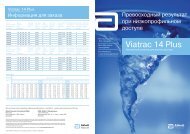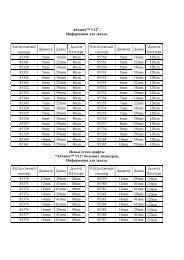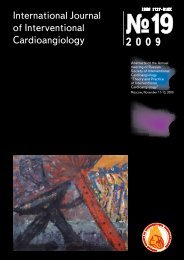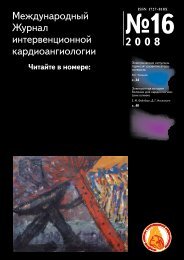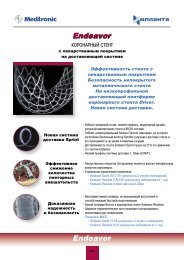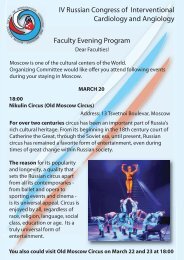International Journal of Interventional Cardioangiology
International Journal of Interventional Cardioangiology
International Journal of Interventional Cardioangiology
You also want an ePaper? Increase the reach of your titles
YUMPU automatically turns print PDFs into web optimized ePapers that Google loves.
INTERVENTIONAL CARDIOLOGY<br />
We used IABP rather widely not only if needed but<br />
with preventive purposes in patients with marked<br />
clinical manifestations <strong>of</strong> CHD, signs <strong>of</strong> heart failure,<br />
which can be increased or provoked by stenting<br />
procedure. This method allows to increase procedure<br />
safety, to create more comfortable conditions<br />
<strong>of</strong> procedure performance both for patient and<br />
operator, IABP can be used as a certain functional<br />
test for objective choice <strong>of</strong> treatment strategy especially<br />
in marked hemodynamic changes. Therefore,<br />
we perform preventive IABP before stenting in<br />
patients with severe coronary disease, especially<br />
when dealing with the single patent artery. IABP was<br />
used during stenting in 28 patients; in the left main<br />
coronary artery stenting we performed preventive<br />
IABP in 79% <strong>of</strong> cases and afterwards we started<br />
the procedure. In 21% <strong>of</strong> patients with less marked<br />
clinical manifestations we performed puncture <strong>of</strong><br />
two femoral arteries with one arterial introducer left<br />
for urgent IABP placement, prepared IABP device<br />
to start its work rapidly within 5-7 minutes after<br />
appearance <strong>of</strong> indications. There was clear effect<br />
from IABP in all cases.<br />
In our opinion, IABP can be used not only as for<br />
treatment purposes, but also as a functional test<br />
while considering the advisability <strong>of</strong> intervention in<br />
patients with severe myocardial damage. The reason<br />
for this hypothesis were two cases <strong>of</strong> the left main<br />
coronary artery stenting with lethal outcomes in<br />
patients with cardiogenic shock, marked disorders<br />
<strong>of</strong> coronary circulation, metabolism, and mechanical<br />
LV activity, admitted for PTCA following CABG.<br />
It was important that IABP performance practically<br />
did not improve hemodynamic parameters in these<br />
patients, and we qualified this as a total depletion<br />
<strong>of</strong> the heart functional reserve, that made us to put<br />
in question the necessity <strong>of</strong> stenting <strong>of</strong> the left main<br />
coronary artery in such patients. Even short term<br />
interruption in LCA blood flow (within 5-10 minutes)<br />
is worse tolerated by exhausted myocardium than<br />
in stable CHD and can be a decisive factor in such<br />
circumstances.<br />
Observation <strong>of</strong> another patient who was denied<br />
stenting due to high risk (as we believed) <strong>of</strong> its<br />
performance, related with marked CHD manifestations,<br />
unstable hemodynamics and heart rate and<br />
absence <strong>of</strong> effect <strong>of</strong> IABP, in our opinion, proved this<br />
viewpoint. However, in approximately one day on the<br />
background <strong>of</strong> patient condition improvement and<br />
stabilization <strong>of</strong> hemodynamics with IABP use, successful<br />
PTCA with the left main coronary artery stenting<br />
was performed.<br />
We understand that these single observations are<br />
rather supporting the need <strong>of</strong> studying <strong>of</strong> this question<br />
ut not any conclusions, and in our practice we<br />
start performing the left main coronary artery stenting<br />
only if clinical or hemodynamic effect <strong>of</strong> IABP is<br />
obtained, because currently we consider this criteria<br />
to be the only objective one for assessment <strong>of</strong> appropriateness<br />
<strong>of</strong> revascularization performance.<br />
CONCLUSION:<br />
In our opinion, a problem <strong>of</strong> determination <strong>of</strong> indications<br />
for one or another method for treating lesion <strong>of</strong><br />
the left main coronary artery remains inadequately<br />
developed. Such factors as lesion localization, its<br />
morphology, number <strong>of</strong> branches originating from<br />
the left main coronary artery, character <strong>of</strong> coronary<br />
artery lesion, presence <strong>of</strong> concurrent pathology<br />
influences treatment strategy for the left main coronary<br />
artery. A small number <strong>of</strong> observations do not<br />
allow to develop the clear system <strong>of</strong> indications and<br />
contradictions for one or another method <strong>of</strong> treatment.<br />
However, the left main coronary artery stenting<br />
showed itself as the effective and safe method <strong>of</strong><br />
treatment for the left main coronary artery lesion.<br />
References:<br />
1. Gruentzig A.R. Transluminal dilatation <strong>of</strong> coronary artery<br />
stenosis. Lancet, 1978, I,263<br />
2. Ellis S.G., Hill C.M., Lytle B.W. Spectrum <strong>of</strong> surgical<br />
risk for left main coronary stenosis: benchmark for potentially<br />
competing percutaneous therapies. Am. Heart. J., 1998,<br />
135,335-338<br />
3. S. J. Brener, B. W. Lytle, I. P. Casserly et al. Propensity<br />
Analysis <strong>of</strong> Long-Term Survival After Surgical or Percutaneous<br />
Revascularization in Patients With Multivessel Coronary<br />
Artery Disease and High-Risk Features Circulation,<br />
2004,109,2290-2295<br />
4. Silvestri M., Lefèvre T., Labrunie P. et al. on behalf <strong>of</strong> the<br />
FLM registry investigators. The French registry <strong>of</strong> left main<br />
coronary artery treatment: Preliminary results. J. Am. Coll.<br />
Cardiol. (suppl.), 2003,41,45A<br />
5. L.A. Bockeria, B.G. Alekyan, Y.I. Buziashvili et. al Immediate<br />
and long-term results <strong>of</strong> left main coronary artery stenting in<br />
patients with coronary heart disease. Kardiologija, 2006, 46,<br />
№3, 4-12.<br />
6. A.B. Mironkov. Coronary angioplasty in potential recipients<br />
<strong>of</strong> donor heart. Candidate’s thesis. Moscow 2007<br />
7. Brigouri C., Sarais C., Pagnotta P. et al. Elective versus<br />
provisional pumping in high-risk percutaneous transluminal<br />
coronary angioplasty. Am. Heart J., 2003, Apr., 145(4),<br />
700-707<br />
Significance <strong>of</strong> Factors Influencing Optimization <strong>of</strong> Stenting <strong>of</strong> the Left Main Coronary Artery<br />
15




